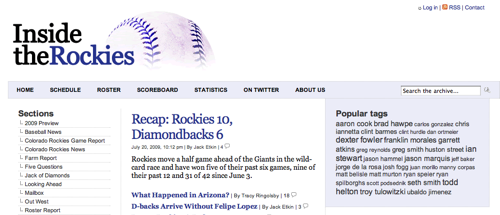 If you’re a Colorado Rockies fan, you can follow your team in any number of ways. There are the obvious national outlets, the Associated Press, the hometown Denver Post, and — before this year’s spring training at least — the Rocky Mountain News, R.I.P. Then there are the television networks and radio stations, and, perhaps most significantly, a growing gauntlet of coverage from Major League Baseball itself from MLB.com. That seems like a pretty saturated market, and we haven’t even broached the many Rockies blogs, fan sites, and message boards, or the community and regional blogs that occasionally join the fray. There’s no shortage of information about the Rockies.
If you’re a Colorado Rockies fan, you can follow your team in any number of ways. There are the obvious national outlets, the Associated Press, the hometown Denver Post, and — before this year’s spring training at least — the Rocky Mountain News, R.I.P. Then there are the television networks and radio stations, and, perhaps most significantly, a growing gauntlet of coverage from Major League Baseball itself from MLB.com. That seems like a pretty saturated market, and we haven’t even broached the many Rockies blogs, fan sites, and message boards, or the community and regional blogs that occasionally join the fray. There’s no shortage of information about the Rockies.
And yet, some of the reporters who know the Rockies better than anyone are working for still another news organization — one they created with that exact saturation in mind. Inside The Rockies — a reported blog launched two days after the Rocky’s closing by the newspaper’s beat writers, Tracy Ringolsby and Jack Etkin, and its assistant sports editor for interactive, Steve Foster — doesn’t aim to supplant the competition. Their goal is to guide the conversation around the Rockies.
Most of the site’s dispatches are short, some as brief as a sentence. The writers aggregate national and local news, and instead of filing traditional game stories, a typical game recap is more of a cross between summary, infographic and notebook. The writers’ contributions are meant, in part, to kickstart the give-and-take in the comments section, where all three are active participants.

The ideas behind Inside The Rockies aren’t new. Most newspaper beat writers keep blogs these days, and there are plenty of good independent endeavors. But for many newspaper reporters, print is still the primary domain, and the traditional one-way communication model of print still rules.
“We’re covering things that other people can cover, but if you go to DenverPost.com, their baseball writers are just talking right past the readers,” Foster, the site’s designer and primary administrator, told me. “The readers might have an ongoing conversation amongst themselves, but you will never hear from those reporters until they put up a new story. We are involved all day with the conversation that’s going on.”
“If they ask a question,” Etkin added, “they get an answer. This is the way the animal is set up, if you will.”
Which might the reason Inside the Rockies’ comment section is significantly more civil than those of its competitors. Fueled by passion about their team, sports fans tend to rant in comments. Some are unintelligible, others bilious, still more speculative; the informed, articulate observer is as rare as a pitcher’s duel at Coors Field. Initially, the site’s staff feared the venomous masses. But those commenters rarely stop by, in part because the three writers are active participants themselves. There hasn’t been a conscientious effort to police comments, Ringolsby said. It’s happened organically — one of the reasons the site has built a niche in a crowded space.
 “The person that comes to the site is coming to the site because that’s what they want to do,” said Ringolsby, noted in the sports community for his ever-present cowboy hat. “You don’t happen onto it, or you don’t see it while you’re reading about the University of Colorado.” In short, because Rockies fans have options to begin with, the ones that frequent the newest site do so because they find some aspect of it appealing, not because it’s long been part of their routine. If they don’t like it, they’ve got plenty of other options.
“The person that comes to the site is coming to the site because that’s what they want to do,” said Ringolsby, noted in the sports community for his ever-present cowboy hat. “You don’t happen onto it, or you don’t see it while you’re reading about the University of Colorado.” In short, because Rockies fans have options to begin with, the ones that frequent the newest site do so because they find some aspect of it appealing, not because it’s long been part of their routine. If they don’t like it, they’ve got plenty of other options.
Few sports blogs can boast of as experienced a team of reporters as Inside the Rockies. Ringolsby and Etkin have covered the Rockies since the team’s inception in 1993; Ringolsby is a past winner of the J.G. Taylor Spink Award, the lifetime-achievement Oscar of the baseball-writing business. With that team in place, they report traffic averaging about 25,000 visits and 80,000 page views a month. Those numbers have been steady, they say, with relatively few big spikes — one notable exception being when manager Clint Hurdle was fired May 29. That speaks to a core group of loyal readers.
The obligatory question: Is there a business model? No, at least not yet. Ringolsby reports on the team at home and on the road, thanks to his gig as a pre-game and post-game presence on Fox Sports’ regional network, and Etkin still covers almost all home Rockies games from the press box. But right now, the income flow is only a trickle on the site. It uses Google AdSense, but with no dedicated ad sales staff, and the site isn’t paying for itself, Foster said.
He hopes that will change soon, but he acknowledged that even for a site with a dedicated readership, charging for memberships or premium content would be tough. “To charge for content that really you can get other places, that’s really difficult to do,” he said. “Admittedly, what we’re providing is not unique to us. But the writers who are providing it are unique to us, and that has value.”
Whether it translates into dollars and cents is, of course, a tenuous proposition. Then again, Inside The Rockies’ model — short posts, containing both original content and aggregated news, meant to provoke a discussion, guided by the reporters — could bring a new angle to the established art of beat reporting, especially with national outlets impeding on local turf. And after all, it’s still early for Inside The Rockies. There are many innings left to be played.